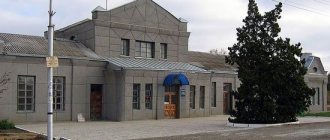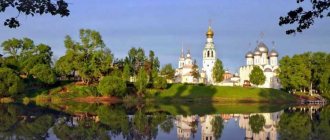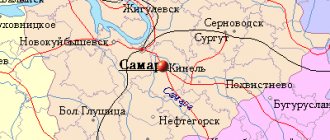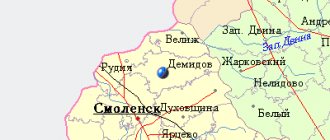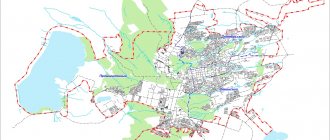(Historical essay) Section: History of Russia Author: Drovaleva Anastasia Yurevna
I was born and live in the most beautiful region of Russia, Krasnodar! In the small town of Apsheronsk. I am a student at the State Budgetary Educational Institution of Secondary Vocational Education “Apsheron Forestry Technical School”. My future profession is a forest regeneration technician. I am passionate about the history of my country and directly the history of my hometown. My city is a regional center with a population of about 40 thousand people. Apsheronsk is located in the southern part of the Krasnodar Territory on the northeastern slopes of the spurs of the Greater Caucasus. The current Apsheronsk is one of the most impressive and picturesque corners of the Krasnodar region. It is considered a promising center for the development of health centers and tourism.
But I want to dwell on the period of the founding of my hometown, when no one could have imagined that there would be a unique area for recreation and recreation, where tourists would come to admire the beauty of our places. I want to talk about an important stage in the history of my hometown from 1863 to 1900, when every piece of land had to be fought for, showing courage and bravery. Not many people know about the history of my hometown, but it has a legendary past that is inextricably linked with Empress Catherine II. At her behest, the Absheronsky regiment of brave Cossacks was organized to defend the southern borders of Russia from the Turkish invasion. These brave warriors not only knew how to conduct combat operations, but were also distinguished by their ability to build.
In January 1863, having completed the construction of the Pshekhinskaya village, the regiment moved further up the Pshekha River. “Having walked 15 versts,” writes the regiment’s historian, “the troops stopped at the confluence of the Tukha River with Pshekha, where it was decided to build a new village and name it in honor of our brave regiment - Absheronskaya.” Many of the detachment liked our places, they moved their families and began to develop the nearby territories. This is how my hometown was founded.
Soon after the founding of the Absheronskaya village, more and more families of immigrants began to arrive there, mainly from the provinces of Ukraine. The oldest settlers of that stage are considered to be the following families: Barabash, Galkin, Goncharov, Gritsenko, Denisenko, Doroshenko, Zarevchatsky, Ilyashenko, Knyazev, Levchenko, Morgunov, Morozov, Motsarev, Ovcharenko, Otryaskin, Plotnikov, Rybalkin, Suprun, Tarasov, Tur, Tsurevsky, Chaikins, Chernyshevs, Shalaevs.
Behind one hut another was built, a church was built, and the first government appeared. A little later, a parish school was opened at the Orthodox Church for local children, who became more and more numerous every year. Before the construction of the school building, the first teacher of the Absheronskaya village, the Cossack constable Eremenko, went directly to the huts and taught the Cossacks to read and write. In 1871, a two-class six-year school was opened in the village (in each class, Cossacks studied for 3 years)... This is how education was organized and the beginning of education was laid in our city of Apsheronsk.
“While the villages were being built and settled, columns of Cossack fighters went on raids to enemy villages and destroyed them,” testifies V.N. Ratushnyak, an expert on the history of Kuban.
Of the ten villages newly built and settled within our Absheronsk region: Pshekhskaya, Kubanskaya, Apsheronskaya, Shirvanskaya, Samurskaya, Bzhedukhovskaya, Kurinskaya, Dagestanskaya, Nizhny Novgorod and Gabukaevskaya (now Ryazanskaya), - by order of the commander of the Caucasian Army in 1863, 26 th cavalry regiment of the Kuban Cossack army with headquarters in the village of Apsheronskaya and was also named Apsheronsky, now after the location of the headquarters. And that Apsheronsky regiment, which founded the Absheronskaya village and gave it its name, continued campaigns to conquer the Caucasus for more than a year, until the end of the Caucasian War in general. For skillful actions and courage shown in the battles for the conquest of the Western Caucasus, the Cossacks of the Absheron regiment were awarded the Horns of St. George. The regiment existed for more than two hundred years, until the formation of the tsarist army ceased.
Many historical books have been written about the Absheron Regiment. In 1896, “Chronicle of the Caucasian Wars” by A.T. was published in Tiflis. Ghisetti.
Captain of the Absheron Regiment L.A. In 1892, Boguslavsky published the “History of the Absheron Regiment” in three volumes, in 1894 the “Absheron Regiment” was created, which contained a brief history of the Absheron Regiment for the soldiers of this regiment, and in 1900 the book “Absheron Regiment 1700 - 1900” was published. In memory of the 200th anniversary of the native regiment." These books, published in St. Petersburg and Moscow, are now stored in the Russian State Library. IN AND. Lenin in Moscow and other Russian libraries.
From sources we learn that Lieutenant Colonel Pistolkors was appointed the first commander of the Absheron Cossack Regiment No. 26 on the basis of the already named newly founded villages. A monument to this heroic man stands in the center of Apsheronsk.
Lieutenant Colonel Pistolkors led the Absheron regiment for a short time - until September 30, 1864, but left a good memory of himself with numerous good deeds for the Cossacks and the local population. He maintained “iron” discipline, and for more than a year of his “reign” not a single Cossack of the regiment was put on trial or subjected to corporal punishment or fines.
The Cossacks, protecting the population, often repelled the raids of the highlanders. In the village of Apsheronskaya, guard gates were built: at Pshekha (where the Maikop Bridge was built later, in 1888) and at the Tukha River. There were also cannons at the guard posts. Around the village on the hills there were watchtowers, on which Cossacks were on duty around the clock, lighting fires in the event of the approach of the highlanders.
In the very first autumn, in 1863, the first schools for teaching children to read and write were opened in the newly built and populated villages. We must pay tribute to the regiment commander A.V. Pistolkors, who understood the need for education and did everything possible to ensure that at least primitive schools were opened. In an order dated October 11, 1863, he wrote, addressing the heads of the villages: “... With the cessation of household work and the beginning of winter, all young children of the Cossacks remain in complete inactivity, meanwhile, the need for education is strongly felt in the Cossack class, and, in the present progressive time, not a single illiterate Cossack can be promoted not only to officers, but even to non-commissioned officers...”
The main sources of livelihood for the population in the first years after the settlement of the Absheronskaya village were the procurement of wild fruits (pears, apples, nuts, dogwood), hunting and fishing. All this gave good income, but after two decades hunting and fishing became a source of entertainment, since the predatory extermination of fish and animals led to their destruction. And by 1900, individual Cossacks began to engage in pottery, cooperage and blacksmithing. During these same years, Greeks and non-Greeks began to grow tobacco.
By this time, a mortar plant, a mill, an oil mill were being built in Apsheronsk, and a number of artisanal artels appeared. But the impetus for the development of industry was the opening of oil fields. In 1865, wells were founded between the villages of Apsheronskaya and Neftyanaya (oil was discovered here in the 10th century).
In 1878, a primitive oil refinery was built, the first oil mills were opened, vast areas were sown with oats and rye... Later, the village of Apsheronskaya was renamed into a city, and then a regional center was formed...
My city is the regional center to this day. There are 260 food and wood processing enterprises on its territory. The region pays great attention to healthcare and education. There are 37 schools here, including a lyceum and a gymnasium, 40 preschool institutions, secondary vocational education institutions and NGOs. And all these enterprises employ the descendants of the first settlers of the Absheronskaya village. Their names are familiar to every resident.
In conclusion, I want to say once again that every person has his own homeland, for one it is his home, for another it is his hometown, and for some it is an entire country. And I am proud to live in the Absheronsky district - the most beautiful and wonderful corner of the vast country of Russia!!!
Sources:
1. B.A. Three brothers. History of Kuban from ancient times to the end of the 18th century. Krasnodar, 2000.
2. V.N. Ratushnyak. History of Kuban from ancient times to the end of the 19th century. Krasnodar, 2000.
3. Kubanoved website https://www.kubanoved.kubannet.ru/
4. Website Caucasian Nature Reserve https://kgpbz.ru/
5. Website of the south of Russia https://www.yuga.ru/
Section: History of Russia Date of publication: 01/14/2014 20:05:14
1
Subscribe to our telegram channel Join our group on VKontakte
Other social networks:
Share material on social networks: You may be interested in other materials from this section:
This must not be forgotten
My great-grandfather on my father’s side, Ismagil Zagitovich Yulaev, was a participant in the Great Patriotic War, a veteran of war and labor. When the war began, he was 22 years old. The young man was among the first to go to the front to defend his homeland and fought in the 112th cavalry division. In 1943, he was seriously wounded at Stalingrad and was hospitalized. The contusion did not allow him to return to duty. Ismagil-olatai was discharged and returned to his native village of Taimas, Kuyurgazinsky district. He led an active lifestyle, worked, forged victory in the rear. I met a beautiful, modest girl, Gafifa, and proposed to her. Together they completed teacher training courses in Sterlitamak and began working at school.
Read
Accommodation in Apsheronsk – hotels and hotels
Motel on Voroshilova is located close to the center. Its rooms look rustic, but the hotel is in demand, tourists leave positive reviews, highlighting the cleanliness and comfort of all rooms. A good location will allow you to use the necessary infrastructure of the city without effort. Nearby guests will find cafes and chain stores. For travelers traveling by private car, parking is provided free of charge. But it is recommended to book rooms in advance.
In Apsheronsk, special attention is paid to the Svetly dispensary. Within the walls of this attractive building, guests will find spacious rooms of various comfort classes. Opposite the base you will find a river, on the banks of which you can simply relax, organize a picnic or go fishing.
The Niagara Hotel offers a wide range of apartments available for booking. The central location ensures accessibility to civilization. Within walking distance are cafeterias, grocery stores, shopping shops, etc. At the hotel, guests can take advantage of a number of additional services: laundry, beauty salon, mini-market and souvenir stall.
You can also stay at the attractive Grant Hotel. The number of rooms is bright, beautiful rooms, which are decorated with exquisite textiles. Guests note that it is quiet and clean. There is free but unguarded parking right in front of the building.
Visitors can rent a nice apartment in the Guest House on Yudina Street. They note the interesting interior of the entire mini-hotel and proximity to infrastructure. It won't be difficult to find a shop or bar in the area.
Dedicated to the memory of Metropolitan Anthony...
Metropolitan Anthony (Alexander Vasilyevich Vadkovsky) left a good memory of himself among the people, and in my article I would like to touch upon the life path of a unique person who was born in our district in 1846.
The fact is that the life of this outstanding person was not so often considered by Spassky local historians. I would like to note that the territory of our region has changed administratively many times, most of it belonged to the Penza province, the other part, incl. and the city of Spassk belonged to the Tambov province. . Read
How to get there (get there)?
Getting to Apsheronsk is not difficult - it is connected by transport links to neighboring regional centers and Krasnodar. In addition, buses passing through the city go to Sochi and other resorts in the Krasnodar Territory, as well as to Astrakhan.
By car from Krasnodar you can independently get to Apsheronsk like this:
The city of Apsheronsk is surrounded by wonderful natural beauty and delights guests with good infrastructure. A vacation here will allow you to enjoy the Krasnodar region to the fullest, move away from noisy, polluted megacities, restore energy, and gain new knowledge and impressions. In conclusion, watch the video about Apsheronsk, enjoy watching!
Class hour "History of the city of Apsheronsk"
History of the formation of the city of Apsheronsk
Apsheronsk
- a city in Russia, the administrative center of the Apsheronsky district of the Krasnodar Territory. Population 40.0 thousand inhabitants (2008). The city is located on the northern slope of the Main Caucasus Range, on the Pshekha River (Kuban basin, left tributary of the Belaya River), 103 km southeast of Krasnodar, 43 km from Belorechensk, 5 km from the border with Adygea.
This year our city turns 150 years old
.
The city was founded in 1863 as a village at the camp of the Absheron regiment
of the Russian army.
History of the Absheron Regiment.
The history of the city of Apsheronsk is connected with the history of the conquest of the Caucasus in general, and its name goes back to the distant past of military campaigns of the oldest regiment of the Russian army - Apsheronsky, which originated from a company in 1700 and was formed as a regiment during the Persian campaigns of Russian troops under Peter. The regiment was named after the place where it was stationed on the Absheron Peninsula (Azerbaijan) during the Persian campaign of Peter I
in 1722 - 1723
Generally speaking, many settlements in the region received their names from the regiments stationed here in the 60s and 70s of the 19th century. There is even a legend that in one night in the 60s of the 19th century, several regiments were massacred by mountaineers. The Absheron regiment
covered its banner with many valiant battles, in particular, it participated in: the siege of the Azov fortress (1736), campaigns in the Crimea (1738 - 1739), a business trip to Sweden (1743), the capture of the Izmail fortress (1791), the Battle of Berezina (1812) ), capture of Paris (1814), storming of the village of Gunib (1859).
In 1862, the regiment set up camp at the confluence of the Tukha and Pshekha
, that is, in the area of the military registration and enlistment office.
The goal was to force the village of Khadyzhi to peace, which was done in 1863. The first villages were: Pshekhskaya, Kubanskaya, Apsheronskaya, Shirvanskaya, Samurskaya
.
The names of the villages, including Absheronskaya, were approved by Emperor Alexander II on September 3, 1863. On the basis of these villages, the 26th cavalry regiment of the 4th brigade of the Linear Cossack Army was formed; this regiment also included the villages of Kurdzhipskaya, Dagestanskaya, Nizhny Novgorod, Bzhedukhovskaya, Tverskaya, Prusskaya (Bezvodnaya)
. The regiment's headquarters was located in the station. Apsheronskaya.
The arrangement of the village was carried out by the commander of the 26th regiment, Lieutenant Colonel A.V.
Pistolkors.
Life of the Cossacks
The first settlers of the village were Seleznev, Nosov, Cherkashin, Nozdrin, Chepurin. Semyon Fedorovich Seleznev was one of the first to build housing.
Since January 1871, the village began to be governed by an elected ataman. This form of government lasted 35 years. During this time, two hub factories, three mills, an oil mill and a brick factory were built. A military hospital with 25 beds was built. The first school, a two-year six-year school, was opened in 1871, and a parochial school was opened in 1890. The first house was located on the site of the modern Gorbushka market; it was an adobe house that existed until the mid-90s.
The Cossack was in the service all his life. He was prepared for this from childhood, teaching him horse riding and the ability to wield a saber, a dagger, and at the same time marksmanship. From the age of 21, a Cossack went into service and served for four years. The Cossacks “managed” their combat horses, ammunition and bladed weapons themselves. After compulsory service in the Russian army, a Cossack until the age of 48 was registered with the military in his village, obeyed his ataman, kept a combat horse, and 3-4 times a year participated in training maneuvers and training camps with trips to field camps.
For service to the Fatherland, a Cossack was entitled to a land allotment, and there was a lot of land, and each born Cossack girl was entitled to a separate land share. The life of the Cossacks was difficult, but more prosperous than that of the peasants of central Russia. The Absheron Cossacks reached their greatest prosperity, as in the whole country, by 1913.
Civil War
The civil war did not spare the Absheronskaya village. At the end of September 1920, 118 Cossacks were killed in the village. At the site of the death of the Cossacks, a six-meter-high Poklonny Cross was erected, near which memorial services are held in memory of the fallen. By the thirties of the twentieth century, the Absheronskaya village had entered the rut of peaceful life. It was during these years that a railway was built into the village, a dairy plant began operating in 1932, and a fruit farm in 1940. The peaceful life of the village, like the entire country, was interrupted by the Second World War.
The Great Patriotic War in the Absheron region
The war in the region lasted from August 14, 1942 to January 27, 1943. This was the Tuapse defensive operation. Mount Opelepen
(height 1010, on maps indicated as height 1006) is a mass grave of many of our compatriots. At the top of the mountain, German soldiers of the Edelweiss group dug in, and Soviet troops took the heights, dropping troops and attacking from the foot of the mountain. Anyone who was there will understand that it was suicide. As a result, we gained altitude. At the top, on the side of the rock, there is a cave; there was a German headquarters there. Why was this height needed? This is an excellent observation point and commanding height over a large section of the Pshekha River valley.
There were also fierce battles for the heights: Bezymyannaya, Tochichnaya, Sarai-mountain, Batareynaya, Semashkho, Outl, Gunai. There is a legend about the Wolf Gate
— they were held for a week by one machine-gun crew of the Red Army.
The partisan movement was developed in the area
- nature favors this. Detachments of V.Z. Stakanova, named after Shchors and others.
The Absheron land raised 7 heroes of the Soviet Union (Volosevich, Gusev, Lyakh, Mishchenko, Slavyansky, Kashcheeva). Suvorov and Novitsky received this title while defending our region.
About 5,000 Soviet soldiers and city residents were buried in the area of the Eternal Flame of Apsheronsk.
Eternal Flame in Apsheronsk
Life after the war
The joy of the victory of the Soviet Union in the Great Patriotic War, the labor enthusiasm that swept the entire country in the second half of the 40s, naturally did not pass by the Absheronians. October 23, 1947
Absheronskaya village received
city
.
An auto repair plant was created, a lumber mill started operating in 1946, a tractor plant started operating in 1953), a timber plant started operating in 1955, and the wood processing plant PDO "Apsheronsk" began operating in 1959. The city is surrounded on almost all sides by dense deciduous forests, including oak, beech, maple, aspen, hornbeam, etc. Such natural resources determined the main direction of the economy of Apsheronsk - logging and wood processing. Tourism
Currently, a new branch of the economy is developing in the region - tourism. The city of Apsheronsk is located in picturesque places. Thanks to the development of the timber industry, Apsheronsk also owes its main attraction - the only narrow-gauge mountain railway in Russia has been preserved here to this day, and most importantly, continues to function.
Recently, the unique railway has been attracting more and more tourists, and this is quite natural - the trip will be remembered for a lifetime! From the city, through majestic forests, along mountain rivers, past steep mountain slopes overgrown with moss and boxwood, an almost toy diesel locomotive slowly pulls a couple of almost toy passenger trailers. And the journey from Guamka to Mezmay will completely captivate your heart - this short section passes through the Guam Gorge - one of the most beautiful places here, where the road passes through a terrace carved into the rock. Welcome to the city of Apsheronsk! Any resident of this city will proudly say: “Apsheronsk is my city, my dearest and most beloved! »
.
Map
| Apsheronsk: maps |
Apsheronsk: photo from space (Google Maps) Apsheronsk: photo from space (Microsoft Virtual Earth)
| Apsheronsk. Nearest cities. Distances in km. on the map (in brackets along roads) + direction. Using the hyperlink in the distance , you can get the route (information courtesy of the AutoTransInfo website) | |||
| 1 | Neftegorsk | 11 () | YU |
| 2 | Khadyzhensk | 16 (22) | Z |
| 3 | Pshekhskaya | 27 () | WITH |
| 4 | Krasnooktyabrsky (Republic of Adygea) | 29 () | NE |
| 5 | Khanskaya (Republic of Adygea) | 30 () | NE |
| 6 | Maykop | 31 (43) | NE |
| 7 | Tula (Republic of Adygea) | 34 (54) | IN |
| 8 | Belorechensk | 35 (40) | WITH |
| 9 | Kamennomostsky (Republic of Adygea) | 39 (80) | SE |
| 10 | Saratovskaya | 50 (60) | NW |
| 11 | Giaginskaya (Republic of Adygea) | 51 (64) | NE |
| 12 | Great | 52 () | WITH |
| 13 | Hot key | 52 (71) | Z |
| 14 | Ponezhukay (Republic of Adygea) | 55 (103) | NW |
| 15 | Ryazan | 56 () | WITH |
| 16 | Yaroslavskaya | 59 () | IN |
| 17 | Adygeisk | 64 (85) | NW |
| 18 | Tuapse | 66 (98) | SW |
| 19 | Dondukovskaya (Republic of Adygea) | 67 (85) | NE |
| 20 | Khakurinokhabl (Republic of Adygea) | 73 () | NE |
| 21 | Starokorsunskaya | 74 (114) | NW |
| 22 | Novomikhailovsky | 74 (139) | Z |
| 23 | Lenin | 75 () | NW |
| 24 | Krasnogvardeyskoe (Republic of Adygea) | 75 () | WITH |
| 25 | Tlustenkhabl (Republic of Adygea) | 77 () | NW |
| 26 | Takhtamukay (Republic of Adygea) | 77 (103) | NW |
| 27 | Koshekhabl (Republic of Adygea) | 77 (104) | NE |
| 28 | Vasyurinskaya | 77 (128) | WITH |
| 29 | Novodmitrievskaya | 79 () | NW |
| 30 | Znamensky | 80 () | NW |
| 31 | Rodnikovskaya | 80 (109) | NE |
| 32 | Labinsk | 80 (94) | IN |
a brief description of
Located in the Ciscaucasia, on the river. Pshekha (Kuban basin). Railway Apsheronskaya station.
In the vicinity of Apsheronsk there are thermal springs of iodine-bromine waters.
Territory (sq. km): 219
Information about the city of Apsheronsk on the Russian Wikipedia website
Historical sketch
Founded in 1863 as a resettlement village at the camp of the Absheron regiment of the Russian army (the regiment was named after the place where it was quartered at the Absheron port during the Persian campaign of Peter I, 1722-23). According to the regiment, the village began to be called Apsheronskaya.
Workers' settlement of Apsheronsk since 1939. City of Apsheronsk since 1947.
Economy
Timber industry enterprise, forestry enterprise, timber processing plant (produce lumber, plywood, veneer, parquet, containers, etc.). Food enterprises. Production of commercial equipment, musical instruments. Processing of medicinal and essential crops.
In the Absheronsk region, chamomile, string, pepper, mint and other medicinal herbs are grown.
Dairy and meat farming.
Main enterprises
FORESTRY, WOOD PROCESSING AND PULP AND PAPER INDUSTRY
JSC "Apsheronsklesprom"
352364, Krasnodar region, Apsheronsky district, Apsheronsk, st.
Kommunisticheskaya, 23 Offers:
Industrial wood, lumber, parquet
Universities of the city
Adygea State University (Apsheron branch)
352690, Krasnodar region, Apsheronsky district, Apsheronsk, st. Lenina, 47
| Population by year (thousands of inhabitants) | |||||||
| 1939 | 22.5 | 1996 | 37.3 | 2007 | 39.6 | 2015 | 40.2 |
| 1959 | 29.8 | 1998 | 37.3 | 2008 | 40.0 | 2016 | 40.3 |
| 1967 | 33 | 2000 | 37.2 | 2010 | 40.1 | 2017 | 40.2 |
| 1970 | 32.9 | 2001 | 37.2 | 2011 | 40.2 | 2018 | 40.0 |
| 1979 | 33.3 | 2003 | 39.6 | 2012 | 40.3 | 2019 | 39.8 |
| 1989 | 34.5 | 2005 | 39.6 | 2013 | 40.3 | 2020 | 39.5 |
| 1992 | 35.3 | 2006 | 39.5 | 2014 | 40.2 | 2021 | 39.2 |

